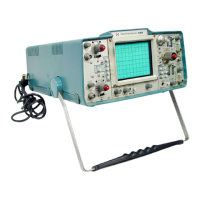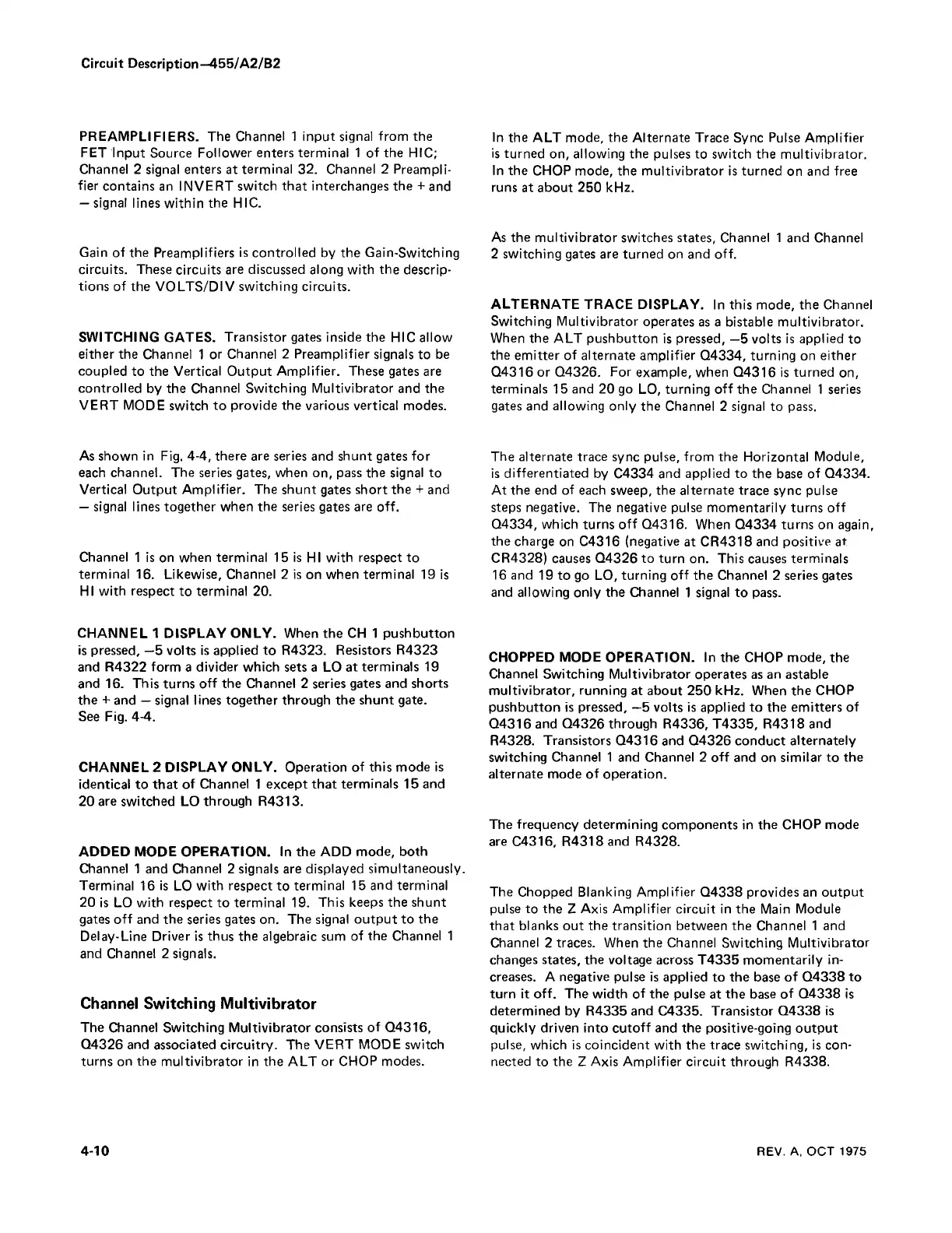Circuit Description—455/A2/B2
PREAMPLIFIERS. The Channel 1 input signal from the
FET Input Source Follower enters terminal 1 of the HIC;
Channel 2 signal enters at terminal 32. Channel 2 Preampli
fier contains an INVERT switch that interchanges the + and
— signal lines within the HIC.
Gain of the Preamplifiers is controlled by the Gain-Switching
circuits. These circuits are discussed along with the descrip
tions of the VOLTS/DIV switching circuits.
SWITCHING GATES. Transistor gates inside the HIC allow
either the Channel 1 or Channel 2 Preamplifier signals to be
coupled to the Vertical Output Amplifier. These gates are
controlled by the Channel Switching Multivibrator and the
VERT MODE switch to provide the various vertical modes.
As shown in Fig. 4-4, there are series and shunt gates for
each channel. The series gates, when on, pass the signal to
Vertical Output Amplifier. The shunt gates short the + and
— signal lines together when the series gates are off.
Channel 1 is on when terminal 15 is HI with respect to
terminal 16. Likewise, Channel 2 is on when terminal 19 is
HI with respect to terminal 20.
CHANNEL 1 DISPLAY ONLY. When the CH 1 pushbutton
is pressed, —5 volts is applied to R4323. Resistors R4323
and R4322 form a divider which sets a LO at terminals 19
and 16. This turns off the Channel 2 series gates and shorts
the + and — signal lines together through the shunt gate.
See Fig. 4-4.
CHANNEL 2 DISPLAY ONLY. Operation of this mode is
identical to that of Channel 1 except that terminals 15 and
20 are switched LO through R4313.
ADDED MODE OPERATION. In the ADD mode, both
Channel 1 and Channel 2 signals are displayed simultaneously.
Terminal 16 is LO with respect to terminal 15 and terminal
20 is LO with respect to terminal 19. This keeps the shunt
gates o ff and the series gates on. The signal output to the
Delay-Line Driver is thus the algebraic sum of the Channel 1
and Channel 2 signals.
Channel Switching Multivibrator
The Channel Switching Multivibrator consists of Q4316,
Q4326 and associated circuitry. The VERT MODE switch
turns on the multivibrator in the ALT or CHOP modes.
In the ALT mode, the Alternate Trace Sync Pulse Amplifier
is turned on, allowing the pulses to switch the multivibrator.
In the CHOP mode, the multivibrator is turned on and free
runs at about 250 kHz.
As the multivibrator switches states, Channel 1 and Channel
2 switching gates are turned on and off.
ALTERNATE TRACE DISPLAY. In this mode, the Channel
Switching Multivibrator operates as a bistable multivibrator.
When the ALT pushbutton is pressed, —5 volts is applied to
the emitter of alternate amplifier Q4334, turning on either
Q4316 or Q4326. For example, when Q4316 is turned on,
terminals 15 and 20 go LO, turning off the Channel 1 series
gates and allowing only the Channel 2 signal to pass.
The alternate trace sync pulse, from the Horizontal Module,
is differentiated by C4334 and applied to the base of Q4334.
At the end of each sweep, the alternate trace sync pulse
steps negative. The negative pulse momentarily turns off
Q4334, which turns off Q4316. When Q4334 turns on again,
the charge on C4316 (negative at CR4318 and positive at
CR4328) causes Q4326 to turn on. This causes terminals
16 and 19 to go LO, turning off the Channel 2 series gates
and allowing only the Channel 1 signal to pass.
CHOPPED MODE OPERATION. In the CHOP mode, the
Channel Switching Multivibrator operates as an astable
multivibrator, running at about 250 kHz. When the CHOP
pushbutton is pressed, —5 volts is applied to the emitters of
Q4316 and Q4326 through R4336, T4335, R4318 and
R4328. Transistors Q4316 and Q4326 conduct alternately
switching Channel 1 and Channel 2 off and on similar to the
alternate mode of operation.
The frequency determining components in the CHOP mode
are C4316, R4318and R4328.
The Chopped Blanking Amplifier Q4338 provides an output
pulse to the Z Axis Amplifier circuit in the Main Module
that blanks out the transition between the Channel 1 and
Channel 2 traces. When the Channel Switching Multivibrator
changes states, the voltage across T4335 momentarily in
creases. A negative pulse is applied to the base of Q4338 to
turn it off. The width of the pulse at the base of Q4338 is
determined by R4335 and C4335. Transistor Q4338 is
quickly driven into cutoff and the positive-going output
pulse, which is coincident with the trace switching, is con
nected to the Z Axis Amplifier circuit through R4338.
4-10
REV. A, OCT 1975

